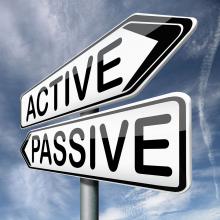
Business, banking, science, art, and a myriad of other sectors prefer, no, demand that you be active rather than passive. The active seize what they want, explore the world around them, and experiment with new approaches and ideas. They are confident, exciting, and innovative. They lead. They take the initiative. They live rich, full lives. By contrast, the passive let life pass them by. They simply accept what others give them and seem to have no will of their own. Which are you?
Most would say they are active. Active is the ideal. If your words in some way represent you, why would you, an active individual, use the passive voice? Your language should be as direct and colorful as you are. Perhaps you simply do not know the difference. Here, I will tell you all you need to know about active and passive language.
Active language is straightforward. You begin with the subject, either the “doer” or the “be-er.”
Such constructions look like this.
DOER
Subject-Verb-Object
The doctor discovered a new cancer treatment.
OR
BE-ER
Subject-BE Verb-Noun or Adjective
The doctor is uniquely qualified to chair the research committee.
By contrast, passive constructions begin with an object being acted upon (receiver).
RECEIVER
Object-BE verb + past participle
The surveys were analyzed.
Passive constructions may include a phrase at the end beginning with “by” to indicate the doer.
The pollen was sprea d by the wind.
d by the wind.
Why would anyone use the passive? The passive is indirect, unclear, often awkward, and wordy. Sentences MAY warrant the passive, for example, 1) when writers do not know who the doer is or the doer is obvious, 2) when they wish to focus on the receiver, 3) or when they wish to avoid the first-person pronoun (I or we).
- The criminal was caught Tuesday. (Active version: The police caught the criminal Tuesday.)
My house was burglarized. (Active version: Someone burglarized my house.)
- Big cats (e.g., lions and tigers) have been hunted to near extinction by humans. (Active version: Humans have hunted big cats (e.g., lions and tigers) to near extinction.
- Informed consent was obtained, and, then, the participants were interviewed. (Active version: Either … The present researchers obtained informed consent and then interviewed the participants. Or … We obtained informed consent and then interviewed the participants.)
However, in almost all contexts, active is better. For those of you seeking dissertation editing services, APA editing services, or journal article editing services, your editor will put all appropriate sentences into the active voice and most likely use first-person pronouns. This may seem wrong, but, nowadays, most of the major styles and journals call for the active, even if that means using the first person. MLA, APA, Chicago, and CSE all ask for the active. Why? Not only is the active more concise and richer in detail (rendering your prose smoother and more interesting), but also we live in a world of increasing accountability and transparency. Readers want to know who did what, how, and when.
